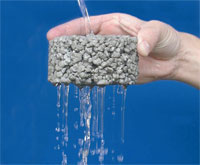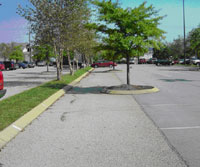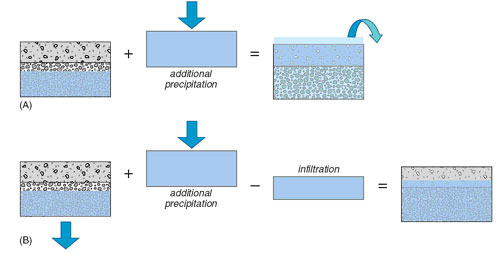
Pervious concrete is a mixture of cement, water, and coarse aggregate, and little to no sand. It also frequently contains chemical admixtures. Pervious concrete creates a very porous medium that allows water to drain to the underlying soils. It is commonly produced to allow as much as five gal/ft²/min to pass through the body of the concrete.
By allowing rain events to penetrate the pavement to the underlying soils, the first flush of the paved surface is contained on site. The natural infiltration of the area remains unchanged so the water can recharge the water table. This avoids surface runoff that must be held in detention ponds or added to the storm water surface runoff, which must then be treated before it is returned to the local streams. In many cases the pavement may also be designed with a layer of coarse granular material below the pavement to increase the storage potential of the system. This has proven to be an effective tool to increase the area of usable pavement on a project as well as satisfy local water management regulations.
See
technical information on pervious concrete.
Hydrologic Design of Pervious Concrete
Pervious concrete has been used in some areas of the country for decades. However recent interest in sustainable development and recognition of pervious pavements by the United States Environmental Protection Agency (EPA) as a best management practice for storm water management has heightened interest in its use. Its use supports national initiatives such as EPA’s Heat Island Reduction Initiative and Low Impact Development and provides a potential for credit in the Leadership in Energy and Environmental Design (LEED®) rating system for sustainable building construction.
Pervious concrete can improve water quality by capturing the “first flush” of surface runoff, reduce temperature rise in receiving waters, increase base flow, and reduce flooding potential. The pavement creates a short-term storage detention of rainfall. In order to fully utilize these benefits, the hydrological behavior of the pervious concrete system must be assessed. The hydrological performance is usually a key parameter in decisions to use this material as a best management practice (BMP) for storm water management and is the characteristic of most interest to permit-granting agencies.
Passive and Active Mitigation Systems
In many situations, the using pervious concrete to replace an impervious surface may be considered a sufficient regulatory standard to manage runoff. In others , the regulations may require that runoff after development not exceed that or a percentage of of runoff prior to development. These two applications are termed passive mitigation and active mitigation, respectively. In the latter case, the pervious concrete pavement system must be designed specifically to handle much more rainfall than that which will fall on the pavement itself. For example, a parking lot can be used to capture excess runoff from rain falling both on itself and on surrounding areas, including, the rain collected and discharged through roof drains of nearby buildings.
Passive Mitigation
A “passive” mitigation element is used only to reduce the quantity of impervious surface in a given area by replacing impervious surface with pervious surface. A passive mitigation element might also capture much, if not all, of the “first flush,” providing additional hydrological benefit, but is not intended to accommodate excess runoff from adjacent surfaces.
Active Mitigation
An “active” mitigation system, on the other hand, is designed to maintain total runoff at some specified level for a particular site with several types of features. Pervious concrete used in an active mitigation system must capture a sizeable portion of the runoff from other areas on site as well as rain falling on its own “footprint.” Typically, such areas include buildings, areas paved with conventional pavement, and traffic islands and buffer zones. Active mitigation systems are particularly well suited to rehabilitating existing impervious areas for remedial control of urban runoff since they can be designed to capture runoff from adjacent areas. Depending on the size, geometry, and porosity of the pervious concrete system, the excess surface runoff from the site can be kept at or returned to pre-development levels. Active pervious concrete pavement systems can also be designed as boundary features used in conjunction with conventional pavement to create a locally active, but site wide passive feature.

Figure 1. Pervious concrete sections in this parking lot (Finley Stadium, Chattanooga, Tennessee) help control runoff. (Photo courtesy of L. Tiefenthaler.)
For example, a pervious concrete system can be designed to capture and temporarily store much, if not all, of the runoff from a conventionally paved parking area by placing a relatively narrow strip of pervious concrete over a deep, clean stone base along the edges of the parking lot (see Fig. 1).
Pervious concrete borders used for tree wells or vegetated traffic islands can be designed as active elements, helping maintain the net runoff from the entire parking area at desired or constrained levels. An important benefit of pervious concrete pavement systems with vegetated islands or tree wells is that adequate moisture may be available with minimal, if any, need for irrigation. This is particularly important when working with minimum tree density requirements or when protecting large, existing trees on the site. The active mitigation design approach is very flexible and can be used for a variety of applications. Primary applications of pervious concrete in an active mitigation role therefore include commercial parking lots, boundary features of commercial development sites, and containment features designed to intercept at least a portion of overland surface runoff prior to entering drainage channels.
The limiting factor for active mitigation applications are poorly draining soils (generally those, with infiltration rates considerably less than 0.1 inches per hour, because the pervious concrete system must be emptied and full storage capacity recovered in a reasonable amount of time (typically five days or less). Recovery time is typically not a major concern in passive mitigation applications with these types of soils since the infiltration is slow and runoff relatively high even with natural cover (see Fig. 2.)

Figure 2. Infiltration of rainfall into the soil increases the effective storage capacity of the pervious concrete pavement system.
Design Storms
Another important consideration in design of a pervious concrete system is the amount of storm water to be stored. Clearly heavier rains result in more runoff. Different sizes of storms will result in different amounts of runoff and the selection of an appropriate design storm is important. Larger storms occur less often on average and storms are typically designated based on their return period. For example, a storm which occurs on average once in 20 years is designated a “20-year storm” and will be larger and produce more rainfall than a “10-year storm.” Often local authorities choose the design storm, such as city or county water boards. Storms of interest in hydrologic design of small watersheds are typically the two-year storm and the 10-year storm. The two-year storm is often used as the “service load” storm for the watershed for water quality purposes. The 10-year storm has traditionally been used in the design of storm water collection systems. Rainfall estimates for many areas are available online at NOAA's National Weather Service.
Resources
Overview of pervious concrete pavement is available though the National Ready Mixed Concrete Association.
Tennis, P. D., Leming, M. L., and Akers, D. J., Pervious Concrete Pavements, EB302, Portland Cement Association, Skokie, Illinois, and National Ready Mix Concrete Association, Silver Spring, Maryland, 2004, 25 pages.